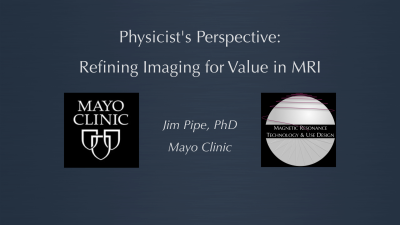ISMRM-SMRT Joint Forum: Chasing Speed & Spatial Resolution: At What Point Is Enough?
ISMRM-SMRT Joint Forum: Chasing Speed & Spatial Resolution: At What Point Is Enough?
Weekday Course
Weekday Course
ORGANIZERS: Claire Mulcahy, Douglas Noll
Monday, 13 May 2019
| Room 710A | 08:15 - 10:15 | Moderators: Sheryl Foster, Stefan Skare |
Skill Level: Basic to Intermediate
Session Number: M-02
Overview
In both the clinical and research MRI environments, there is ever-increasing pressure to reduce imaging times whilst improving diagnostic & research information. Over the past two decades, there has been considerable focus on techniques to reduce scan times, improve image resolution, and develop new sequences that facilitate both faster and higher resolution scanning.
The aim of this forum is to initiate a discussion that asks: Is there a point at which the diagnostic capability/usefulness of MRI data is not improved by higher resolution and faster acquired images? The anatomical focus of the forum is neuro-imaging, where a scientist, radiographer/technologist, radiologist, and neurosurgeon will present their professional perspectives.
Target Audience
Radiologists and radiographers/technologists will benefit most from this forum, learning about the needs for imaging speed and spatial resolution. Scientists and trainees interested in clinical needs will also benefit.
Educational Objectives
As a result of attending this course, participants should be able to:
- Identify up-to-date fast MR imaging techniques (including acquisition technology and reduced scanning protocols);
- Articulate the benefits of shorter MR examination times;
- Evaluate any advantages and disadvantages of acquiring increased spatial resolution; and
- Identify the different goals in MRI data acquisition for scientists, clinicians, and radiographers/technologists.
Overview
In both the clinical and research MRI environments, there is ever-increasing pressure to reduce imaging times whilst improving diagnostic & research information. Over the past two decades, there has been considerable focus on techniques to reduce scan times, improve image resolution, and develop new sequences that facilitate both faster and higher resolution scanning.
The aim of this forum is to initiate a discussion that asks: Is there a point at which the diagnostic capability/usefulness of MRI data is not improved by higher resolution and faster acquired images? The anatomical focus of the forum is neuro-imaging, where a scientist, radiographer/technologist, radiologist, and neurosurgeon will present their professional perspectives.
Target Audience
Radiologists and radiographers/technologists will benefit most from this forum, learning about the needs for imaging speed and spatial resolution. Scientists and trainees interested in clinical needs will also benefit.
Educational Objectives
As a result of attending this course, participants should be able to:
- Identify up-to-date fast MR imaging techniques (including acquisition technology and reduced scanning protocols);
- Articulate the benefits of shorter MR examination times;
- Evaluate any advantages and disadvantages of acquiring increased spatial resolution; and
- Identify the different goals in MRI data acquisition for scientists, clinicians, and radiographers/technologists.
| 08:15 |
 |
Physicist's Perspective: Reduction of Imaging for Value in MRI
James Pipe
MRI technology is extremely powerful but relatively expensive, somewhat unreliable, complex to operate, and (thus) often poorly utilized. While most institutions attempt to optimize MRI for specific use cases, the variations in “optimal” protocols across institutions (and radiologists) reflect a lack of objective criteria for diagnosis. Arguably, even the standardization of exam slot times reflects institutions’ need for efficient scheduling, rather than optimal allocation of resources to individual patient care. This all presents great opportunity for increasing the impact of MRI on patient care while simultaneously reducing the cost of healthcare with more efficient, targeted, accurate and actionable diagnostic scans.
|
| 08:45 |
Radiologist's Perspective: Reduction of Imaging for Value in MRI
Scott Reeder
|
|
| 09:15 |
Radiographer's Perspective: Reduction of Imaging for Value in MRI
Emma Hornsey
MRI is of high diagnostic value but it is historically slow and expensive. Reducing imaging can diminish these obstacles and create value through access. Advances in technology and working smarter with existing resources can significantly reduce examination times. Improved access to imaging and better patient tolerance of examinations will see MRI become a front line imaging modality. As more patients benefit from quicker diagnosis, timely treatment and better outcomes the clinical demand for MRI will only continue to grow. The ongoing challenges within this field will be maintaining adequate levels of patient care and Radiographer job satisfaction
|
|
| 09:45 |
Neurosurgeon's Perspective: Reduction of Imaging for Value in MR
Alexander Weil
|
|
| 10:15 |
Adjournment |
 Back to Program-at-a-Glance |
Back to Program-at-a-Glance |  Back to Top
Back to Top